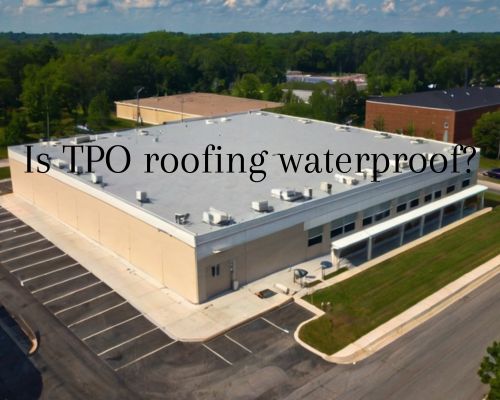Thermoplastic Polyolefin (TPO) roofing has gained a strong reputation in the commercial roofing industry for its durability and performance.
If you’re considering TPO roofing for your property, you’re likely asking: Is TPO roofing waterproof? Let us know it with Charles Jimerson from CJ Commercial Roofing NJ.

The answer is yes, TPO roofing is designed to be highly waterproof. This is thanks to its single-ply membrane that provides effective protection against water infiltration.
TPO roofing materials include layers that enhance their waterproof capabilities, such as an anti-oxidation membrane and a non-woven fabric layer.
These components work together to ensure that your roof remains secure against various weather conditions. With its heat-weldable seams, TPO roofing also offers enhanced security. This makes it easier to repair and diagnose leaks if they occur.
In addition to being waterproof, TPO roofing is environmentally friendly and energy-efficient.
The material’s UV resistance helps reflect sunlight, reducing energy costs for cooling your building.
As you explore your roofing options, understanding the benefits of TPO will help you make an informed decision for your property’s needs.
Composition and Properties of TPO Roofing
TPO roofing is a single-ply roofing membrane known for its durability and energy efficiency. Its composition and properties make it a popular choice for commercial roofing projects.
Fundamentals of TPO Membrane
TPO stands for Thermoplastic Polyolefin, a blend of polypropylene and ethylene-propylene rubber.
The membrane typically includes a reinforced scrim—usually made from polyester fabric—that enhances its strength and puncture resistance. These features contribute to its flexibility and waterproofing capabilities, making it a reliable choice for various climates.
The TPO polymer’s composition provides inherent UV resistance, ideal for roofs exposed to sunlight. Heat-weldable seams ensure a tight, waterproof seal, which adds to its resilience.
TPO vs Other Roofing Materials
When comparing TPO to other roofing materials such as EPDM and PVC, key differences emerge.
Unlike EPDM (ethylene propylene diene monomer), which is rubber-based, TPO offers superior heat-welded seams for enhanced durability.
In contrast to PVC (polyvinyl chloride), TPO is more environmentally friendly. This is because it lacks the plasticizers that can break down over time. TPO also outperforms traditional asphalt roofing due to its single-ply nature, reducing installation complexity and weight on the building structure.
Benefits of Thermoplastic Technology
Thermoplastic technology in TPO roofing offers several benefits.
One significant advantage is its excellent flexibility, which allows the material to expand and contract with temperature changes without cracking. This adaptability prolongs the roof’s lifespan.
The membrane’s durability is enhanced by its heat-weldable seams that prevent leaks and make maintenance easier. Low maintenance requirements and high resistance to dirt, algae, and bacteria make TPO ideal for commercial roofing.
“Energy efficiency is another crucial benefit. The reflective surface of TPO membranes helps reduce cooling costs by reflecting sunlight, which is beneficial in warm climates.” said Charles Jimerson from CJ Commercial Roofing NJ.
Installation and Performance
Proper installation of TPO roofing ensures durability and effectiveness. Considerations include adherence to best practices, maintenance routines, and impacts on energy efficiency.
Proper Installation Techniques
Correct installation of TPO roofing is crucial for preventing leaks and maximizing performance.
TPO membranes are typically installed using adhesives, mechanical fasteners, or heat welding methods.
Heat welding is often preferred due to its strong, seamless bonds. Ensuring proper overlaps, scrim reinforcement, and attention to detail minimizes punctures and wind uplift.
Engage experienced roofing contractors to maintain quality and reduce labor costs in the long run.
Correct installation also involves prefabricated accessories like corners and vents, which help in maintaining the integrity of the roof.
Properly installed TPO can withstand extreme temperatures and heavy foot traffic, making it an excellent choice for commercial buildings.
Maintenance and Longevity
Routine maintenance extends the lifespan of your TPO roof. Regular roof inspections should be scheduled to check for damage, wear, and cleanliness.
Cleaning the roof membrane periodically helps maintain its reflective properties, which are essential for energy efficiency.
Longevity typically ranges from 15 to 30 years, depending on the quality of installation and maintenance. Warranties often cover up to 20 years, providing added assurance.
Fasteners and seams should be checked regularly for any signs of wear or potential leaks. Engaging professional roofing contractors for maintenance ensures minor issues don’t escalate into costly repairs.
Environmental and Energy Considerations
TPO roofing is known for its energy efficiency and minimal environmental impact.
Available in reflective colors like white, TPO membranes help reduce energy bills by reflecting UV rays, creating what is known as a cool roof.
This reflective property can significantly lower cooling costs in commercial buildings.
TPO is also recyclable, adding to its environmental benefits.
Its affordable installation cost and durability make it a cost-effective, sustainable option.
Additionally, TPO performs well under extreme temperatures, offering excellent thermal resistance.
This contributes not only to energy efficiency but also to the overall lifespan and cost-effectiveness of the roof.